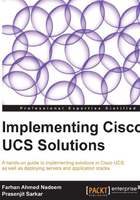
What this book covers
Chapter 1, Cisco UCS Physical Architecture and Installing UCS Hardware, covers physical components of UCS solutions including Fabric Interconnects, blade chassis, IOM/FEX modules, mezzanine cards, blade servers, and rack-mount servers. Specifications of different components are provided along with the physical installation and connectivity of all of the components.
Chapter 2, Setting Up Lab Using Cisco UCS Emulator, introduces the UCS Emulator, which is an excellent tool from Cisco to learn UCS even without a physical lab. Different UCS Emulator installation options are discussed, and configuring the UCS Emulator for lab usage is explained.
Chapter 3, Configuring Cisco UCS Using UCS Manager, gives an overview of UCS Manager, which is the core management tool for the UCS platform. Readers get acquainted with the UCS Manager navigation and configuration options using both graphical user interface and command-line interface.
Chapter 4, Configuring LAN Connectivity, explains UCS network connectivity. UCS platform-unique features, including Fabric Interconnect operational modes, pin groups, port channels, virtual PortChannel, and virtual network interface card configuration, are explained along with both northbound and southbound network connectivities from Fabric Interconnects.
Chapter 5, Configuring SAN Connectivity, explains storage connectivity for different SAN protocols supported by the UCS platform. Configuration of protocols including FC, FCoE, and iSCSI is discussed along with an introduction to UCS unique features including FC operational modes, VSANs, and uplink pinning.
Chapter 6, Creating Identity and Resource Pools, introduces identity and resource pools which include UUID, MAC addresses, WWN, and server pools. Identity and resource pools are used for abstracting unique identities and resources for devices such as vNICs; vHBAs and server pools can assign servers in groups based on similar server characteristics.
Chapter 7, Creating and Managing Service Profiles, shows how to create service profiles that provide necessary identities, resources, and configuration to the stateless servers. Readers first learn how to create policies which provide server configuration, and then learn various service profile configuration options.
Chapter 8, Managing UCS through Routine and Advanced Management, introduces the most common and advanced management tasks performed with UCS, from startup and shutdown to logging, upgrading firmware, licensing, and role-based access. These routine management tasks are crucial to understand in order to effectively administer Cisco UCS.
Chapter 9, Virtual Networking in Cisco UCS, explains the integration of Cisco UCS and the virtualization of hypervisor mostly with VMware vSphere and Cisco Nexus 1000v Distributed Virtual Switch.
Chapter 10, Configuring Backup, Restore, and High Availability, covers UCS backup and restore options. This chapter also provides details of high-availability configuration for UCS Fabric Interconnects.
Chapter 11, Cisco UCS Failure Scenarios Testing, discusses various failure scenarios that provide necessary knowledge for UCS troubleshooting for identifying and resolving issues.
Chapter 12, Third-party Application Integration, covers third-party applications including VMware vCenter extension, goUCS automation toolkit, EMC UIM, and so on.
What you need for this book
In order to create a lab without physical equipment and to practice procedures provided in this book, you will need the following:
- A UCS Emulator virtual machine that provides UCS Manager application and emulated hardware.
- A hypervisor that can run the UCS Emulator VM. Options include VM Player, VM Workstation, VM Fusion, vSphere, and HyperV.
- A client machine with an Internet-Explorer- or Mozilla-compatible browser for accessing the UCS Manager application.